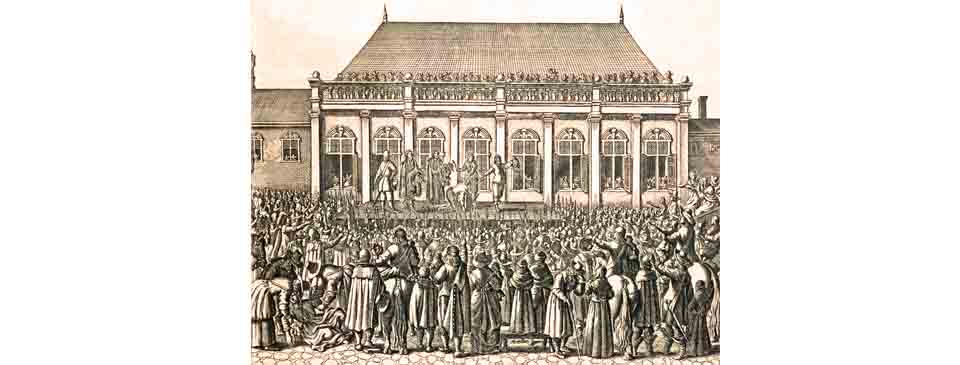The Trial and Execution of King Charles I

Pictures showing the execution of Charles I at Banqueting House were forbidden in England but soon began to appear on the Continent. The earliest engraving appeared several weeks after the event in the book ‘Theatrum Tragicum’, published in Amsterdam. A woman in the bottom left of the picture feints as the assistant executioner holds aloft the severed head of the King.
There is some doubt as to the identity of the two executioners, who were disguised with false hair and a beard. Richard Brandon, the usual executioner denied it was his work, yet it was reported that the head was severed with one blow and a later post-mortem in the 19th century established that it was certainly the work of an experienced man.
In the crowd was the 15-year old Samuel Pepys. The young schoolboy had been raised in a Puritan family who would have considered the King to be a tyrant. In later life, when he served under Charles II and his brother the Duke of York, Pepys would remember his younger self as “a roundhead”.
The Bishop and Herbert went with the body. The head was sewn back on the body by Mr. Topham, private surgeon to Sir Thomas Fairfax, which Topham embalmed at St. James’s Palace. In February Charles was buried in St. George’s chapel at Windsor Castle. The gloves he wore during the execution are now on display in the Great Hall of Lambeth Palace.
Charles is the only English monarch to be executed. He still had many supporters and the regicide was undertaken by a small minority of radicals. There was great shock around the country. Charles was also King of Scotland and Ireland and the English had executed their monarch and alienated those nations. The monarchy was abolished, and so too was the House of Lords, which had failed to sanction the execution.
Two weeks after the execution five of the Royalist leaders during the Civil War, the Duke of Hamilton, Lords Holland, Norwich and Capel, and Sir John Owen, were brought to trial. All were found guilty of high treason and sentenced to death. Lord Norwich and Owen were reprieved. The other three were beheaded three days later at New Palace Yard at Westminster.
In 1662, after the monarchy was restored, Charles was declared a martyr and a saint by the Church of England, the last person to be canonized by the English Church. A devotional cult was established in his name. The Society of King Charles the Martyr was founded in 1894 and is still active.
Sources include: Hilary St. George Saunders ‘Westminster Hall’ (1951); Edgar Sheppard ‘The Old Palace of Whitehall’ (1902); Barry Coward ‘The Stuart Age’; John Richardson ‘Annals of London’; Samuel Coote ‘Samuel Pepys – A Life’; The Diary of Samuel Pepys; Robin Rowles ‘The Civil War in London’; Robert Brenner ‘Merchants and Revolution’; Lisa Jardine ‘On A Grander Scale’.
< Back to Towards the Second Civil War
Forward to London during the Commonwealth


